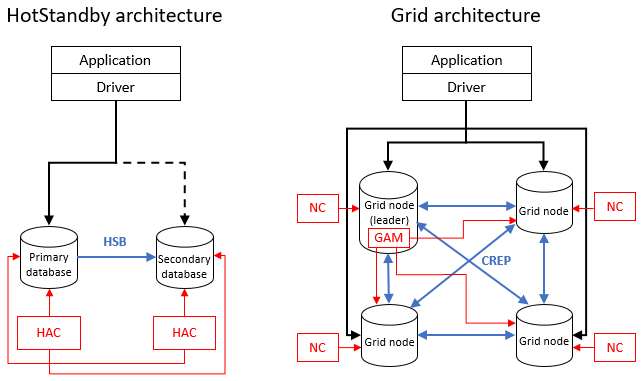

Category | HSB | Grid |
|---|---|---|
Server count | 2 | No limit |
Replication mechanism | Synchronous replication (by default), however, asynchronous replication is supported by configuration. | Asynchronous replication. Note Internally, a grid uses C Replicator (CREP) for replication, see C Replicator. |
Replication factor | 2 | Configurable |
Fault tolerance mechanism and required components | If a database instance is lost, an external entity is required to manage state transition of the remaining database. solidDB includes the High Availability Controller (HAC) for this purpose, see High Availability Controller. | If a database instance, is lost, grid nodes automatically relocate data to retain the required replication factor. solidDB includes the Node Controller (NC) to manage the restart of the failed database instance, see Node controller, and the Grid Availability Manager (GAM) to maintain the replication factor, see Grid Availability Manager. |
Category | HSB | Grid |
|---|---|---|
Write scalability | Generally the same as for a single server Some additional performance can be expected if you use relaxed durability with transaction logging, see Durability and logging. | Throughput performance (compared with a single node) can be increased by up to a multiple of the number of nodes in the grid. |
Read scalability | Up to twice the throughput performance of a single server, due to being able to route read transactions to the secondary database | Throughput performance (compared with a single node) can be increased by up to a multiple of the number of nodes in the grid. |
Capacity limit | Same capacity as a single server | Capacity (compared with a single node) can be increased by up to a multiple of the number of nodes in the grid. |
Write latencies | Similar to standalone database | Similar to standalone database Note Only single row operations are supported. |
Read latencies | Similar to standalone database | Similar to standalone database when a query retrieves data from a single node |
Category | HSB | Grid |
|---|---|---|
SQL limitations | None Transparent to an application working with a single server system | Limitations for write operations across nodes, see Routing INSERT, UPDATE and DELETE statements Limitations in procedure and trigger behavior, see Transaction includes a stored procedure Applications need to be aware of grid SQL limitations |
Schema limitations | No schema limitations | Foreign keys not supported |
Online software upgrades for solidDB binaries | Supported | Supported |
Supported interfaces | ODBC JDBC SA | ODBC JDBC |
solidDB utility support | solidDB SQL Editor (solsql) solidDB Speed Loader (solload) solidDB Export (solexp) solidDB Data Dictionary (soldd) | solidDB SQL Editor (solsql) solidDB Speed Loader (solload) solidDB Export (solexp) solidDB Data Dictionary (soldd) |
Automatic SQL routing by driver | Yes (ODBC and JDBC) | Yes (ODBC and JDBC) |